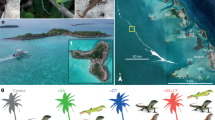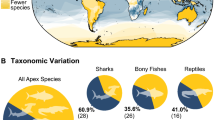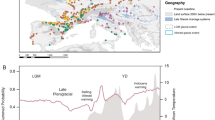Abstract
The Iberian lynx (Lynx pardinus) has suffered severe population declines in the twentieth century and is now on the brink of extinction1. Climate change could further threaten the survival of the species2, but its forecast effects are being neglected in recovery plans3,4. Quantitative estimates of extinction risk under climate change have so far mostly relied on inferences from correlative projections of species’ habitat shifts5. Here we use ecological niche models coupled to metapopulation simulations with source–sink dynamics6,7 to directly investigate the combined effects of climate change, prey availability and management intervention on the persistence of the Iberian lynx. Our approach is unique in that it explicitly models dynamic bi-trophic species interactions in a climate change setting. We show that anticipated climate change will rapidly and severely decrease lynx abundance and probably lead to its extinction in the wild within 50 years, even with strong global efforts to mitigate greenhouse gas emissions. In stark contrast, we also show that a carefully planned reintroduction programme, accounting for the effects of climate change, prey abundance and habitat connectivity, could avert extinction of the lynx this century. Our results demonstrate, for the first time, why considering prey availability, climate change and their interaction in models is important when designing policies to prevent future biodiversity loss.
This is a preview of subscription content, access via your institution
Access options
Subscribe to this journal
Receive 12 print issues and online access
$209.00 per year
only $17.42 per issue
Buy this article
- Purchase on Springer Link
- Instant access to full article PDF
Prices may be subject to local taxes which are calculated during checkout



Similar content being viewed by others
References
Palomares, F., Rodríguez, A., Revilla, E., López-Bao, J. & Calzada, J. Assessment of the conservation efforts to prevent extinction of the Iberian lynx. Conserv. Biol. 25, 4–8 (2011).
Thomas, C. D. Translocation of species, climate change, and the end of trying to recreate past ecological communities. Trends Ecol. Evol. 26, 216–221 (2011).
Gil-Sánchez, J. M., Arenas-Rojas, R., Garcéa-Tardéo, M., Rodríguez-Siles, J. & Simón-Mata, M. A. Habitat assessment to select areas for reintroduction of the endangered Iberian lynx. Wildife Biol. Pract. 7, 1–19 (2011).
Simón, M. et al. Reverse of the decline of the endangered Iberian lynx. Conserv. Biol. 26, 731–736 (2012).
Thomas, C. D. et al. Extinction risk from climate change. Nature 427, 145–148 (2004).
Keith, D. A. et al. Predicting extinction risks under climate change: Coupling stochastic population models with dynamic bioclimatic habitat models. Biol. Lett. 4, 560–563 (2008).
Fordham, D. A., Akçakaya, H. R., Araújo, M. B., Keith, D. A. & Brook, B. W. Tools for integrating range change, extinction risk and climate change information into conservation management. Ecography http://dx.doi.org/10.1111/j.1600-0587.2013.00147.x (2013).
Rodríguez, A. & Delibes, M. Internal structure and patterns of contraction in the geographic range of the Iberian lynx. Ecography 25, 314–328 (2002).
Delibes-Mateos, M., Ferreras, P. & Villafuerte, R. European rabbit population trends and associated factors: A review of the situation in the Iberian Peninsula. Mammal Rev. 39, 124–140 (2009).
Delibes, M., Rodríguez, A. & Ferreras, P. Action Plan for the Conservation of the Iberian Lynx (Lynx pardinus) in Europe (Nature and Environment Series, Vol. 111, Council of Europe Publishing, 2000).
Rodríguez, A. & Delibes, M. Patterns and causes of non-natural mortality in the Iberian lynx during a 40-year period of range contraction. Biol. Conserv. 118, 151–161 (2004).
Vargas, A. et al. The Iberian lynx Lynx pardinus conservation breeding program. Int. Zoo Yearbk 42, 190–198 (2008).
López-Bao, J. V., Rodríguez, A. & Palomares, F. Behavioural response of a trophic specialist, the Iberian lynx, to supplementary food: Patterns of food use and implications for conservation. Biol. Conserv. 141, 1857–1867 (2008).
Bellard, C., Bertelsmeier, C., Leadley, P., Thuiller, W. & Courchamp, F. Impacts of climate change on the future of biodiversity. Ecol. Lett. 15, 365–377 (2012).
Delibes-Mateos, M., Delibes, M., Ferreras, P. & Villafuerte, R. Key role of European rabbits in the conservation of the western Mediterranean basin hotspot. Conserv. Biol. 22, 1106–1117 (2008).
Kissling, W. D. et al. Towards novel approaches to modelling biotic interactions in multispecies assemblages at large spatial extents. J. Biogeogr. 39, 2163–2178 (2012).
Wigley, T. M. L. et al. Uncertainties in climate stabilization. Climatic Change 97, 85–121 (2009).
Wigley, T. M. L. Could reducing fossil-fuel emissions cause global warming? Nature 349, 503–506 (1991).
Wigley, T. M. L., Richels, R. & Edmonds, J. A. Economic and environmental choices in the stabilization of atmospheric CO2 concentrations. Nature 379, 240–243 (1996).
Griffith, B., Scott, J. M., Carpenter, J. W. & Reed, C. Translocation as a species conservation tool: Status and strategy. Science 245, 477–480 (1989).
Vilà, M. & Hulme, P. Jurassic Park? No thanks. Trends Ecol. Evol. 26, 497–498 (2011).
Rodríguez, A., Calzada, J., Revilla, E., López-Bao, J. V. & Palomares, F. Bringing science back to the conservation of the Iberian lynx. Conserv. Biol. 26, 737–739 (2012).
Ferrer, M. & Negro, J. J. The near extinction of two large European predators: Super specialists pay a price. Conserv. Biol. 18, 344–349 (2004).
Hoegh-Guldberg, O. et al. Assisted colonization and rapid climate change. Science 321, 345–346 (2008).
Alagador, D. et al. Linking like with like: Optimising connectivity between environmentally-similar habitats. Landscape Ecol. 27, 291–301 (2012).
Fischlin, A. et al. in Impacts, Adaptation and Vulnerability (ed. Parry, M. L.) 211–272 (Cambridge Univ. Press, 2007).
Fordham, D. A., Wigley, T. M. L., Watts, M. J. & Brook, B. W. Strengthening forecasts of climate change impacts with multi-model ensemble averaged projections using MAGICC/SCENGEN 5.3. Ecography 35, 4–8 (2012).
VanDerWal, J., Shoo, L. P., Johnson, C. N. & Williams, S. E. Abundance and the environmental niche: Environmental suitability estimated from niche models predicts the upper limit of local abundance. Am. Natur. 174, 282–291 (2009).
Stanton, J. C., Pearson, R. G., Horning, N., Ersts, P. & Akçakaya, H. R. Combining static and dynamic variables in species distribution models under climate change. Methods Ecol. Evol. 3, 349–357 (2012).
Pagel, J. & Schurr, F. M. Forecasting species ranges by statistical estimation of ecological niches and spatial population dynamics. Glob. Ecol. Biogeogr. 21, 293–304 (2012).
Acknowledgements
This research was initiated in a workshop at the National Museum of Natural Sciences, Madrid, led by M.B.A. and funded by FP6-MACIS SSP/STREP/0778. Australian Research Council (ARC) supported D.A.F., B.W.B. and M.J.W. (LP0989420, DP1096427, FT100100200 and FS110200051); NASA NNX09AK19G and NSF DEB-1146198 supported H.R.A.; FCT PTDC/AAC-AMB/98163/2008, Integrated Program of IC&DT No 1/SAESCTN/ALENT-07-0224-FEDER-001755, and Danish NSF supported M.B.A.; Spanish Research Council (CSIC; grant 200830I195) and the Andalusian Department of Innovation and Science (P06-RNM-01903) supported A.R. E. Virgós and C. Ferreira provided further expert advice on rabbit distribution and abundance. C. Mellin and N. Clisby generated the figures.
Author information
Authors and Affiliations
Contributions
The design of this project was the result of discussions involving all authors. M.B.A generated the ENMs. D.A.F., H.R.A., A.R., P.C.A, E.C. and M.T. coupled the ENMs to metapopulation simulations. D.A.F., H.R.A., B.W.B. and M.J.W. performed the analysis. D.A.F. and M.B.A. wrote the initial draft of the manuscript; and all authors contributed to the writing of the final version of the paper. All authors discussed the results and commented on the manuscript.
Corresponding author
Ethics declarations
Competing interests
The authors declare no competing financial interests.
Supplementary information
Rights and permissions
About this article
Cite this article
Fordham, D., Akçakaya, H., Brook, B. et al. Adapted conservation measures are required to save the Iberian lynx in a changing climate. Nature Clim Change 3, 899–903 (2013). https://doi.org/10.1038/nclimate1954
Received:
Accepted:
Published:
Issue Date:
DOI: https://doi.org/10.1038/nclimate1954
This article is cited by
-
A guide to ecosystem models and their environmental applications
Nature Ecology & Evolution (2020)
-
Assessing the influence of ecological interaction patterns among habitat types on species distribution: studying the Iberian lynx (Lynx pardinus Temminck 1827) in central Spain
Landscape Ecology (2020)
-
Threat of climate change on a songbird population through its impacts on breeding
Nature Climate Change (2018)
-
Planning for the future: identifying conservation priority areas for Iberian birds under climate change
Landscape Ecology (2018)
-
Predictor weighting and geographical background delimitation: two synergetic sources of uncertainty when assessing species sensitivity to climate change
Climatic Change (2017)



